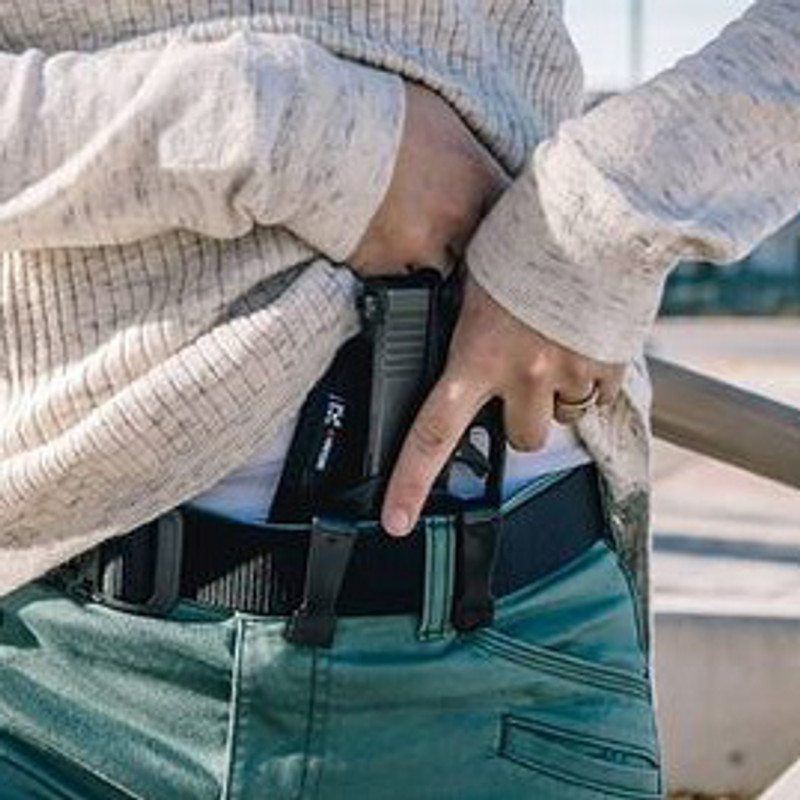|
Where to Carry? When you make the decision to carry concealed, one important consideration is where on your body you will conceal your weapon. Most holsters are designed around a certain carry position and if you’re still researching which holster is best for you, here are three positions that are the most common. We'll go over the pros and cons of each. Inside the Waistband (IWB) Wearing your holster "IWB" means positioning it between your body and the inside of your waistband. We will use "clock" positions to orient ourselves here. For right-hand dominant shooters, square on the strong side hip is 3 o’clock, just behind the hip is 4 o’clock, and right next to the kidney is 5 o’clock. The traditional IWB position for a right handed shooter is 4:30. This position is highly concealable for a wide range of body types and still allows for a natural draw motion. This is the most common way to carry a concealed firearm due to how adaptable it is for different body types. Some of the cons, or at least things to be aware of when carrying in this position: bending at the waist can cause the grip of the firearm to "print" - meaning the shape of the firearm becomes apparent through your shirt. Another con to traditional IWB carry is drawing from a seated position in a chair, particularly while seated in a vehicle. Even with extensive training, the speed of your draw will be affected when in this position. Appendix Inside the Waistband (AIWB) Appendix IWB carry is when the holster is positioned inside the waistband at the front of the body. Typically around the 1 o’clock position (for right handed shooters) or right beside the belt buckle. The pros to AIWB carry is the accessibility to the firearm for a draw that can be quicker than from the traditional behind-the-hip position. The AIWB draw motion is also a less telegraphed motion compared to reaching behind your back. It is also easier to access your firearm from the appendix position while seated. Another benefit to AIWB over IWB carry is that firearm is always in front of you which makes it easier to defend - as opposed to IWB carry where an assailant could more easily approach your back and attempt to disarm you from behind. Some cons to AIWB carry: it's more sensitive to different body types and how high or low the waistband of your pants sit on your body when compared to the traditional behind-the-hip position. If you need to bend over at the waist the grip and slide of the gun will push into your stomach and may cause discomfort. The length of the slide of your firearm is also a factor. A long slide and a waistband that sits below your true waist, closer to your hips, can result in a pressure point against your groin/thigh area when bending or sitting. Outside the Waistband (OWB) OWB is the original form of carrying a handgun, with the holster hanging on your belt outside your waistband just like the westerns of old. Because the firearm is no longer between you and your clothing, this is the most comfortable carry method by far. The downside to OWB carry is that it is best suited for "open carry". If you prefer OWB for comfort but also require concealment you will need to dress around it. A loose fitting shirt, sweatshirt, or light jacket works well. Weather will play a part in how comfortable it is to conceal carry with the OWB method. It may be more comfortable on the hip but you may end up wearing clothes not ideal for summer temps in order to conceal it. Choosing where to carry concealed must be done with safety and comfort in mind. Once you've decided where you want to carry - practice in your house as many body movements you can think of with your firearm holstered in that position. You want to be aware of how your body works with that carry position before you head out the door. After you learn what works and what doesn't safely practice your draw every day from different positions (standing, seated, crouched, etc). Also, your best concealed carry option may depend on a given situation. For some this means having a variety of holsters for different positions in order to adapt as needed. Maybe you decide to carry OWB in the Fall and Winter but switch to IWB in the Summer. Or if you're making a cross country drive on vacation, you opt for AIWB but when you get back to the office it's back to the traditional IWB. Wherever you choose to carry on your person, be sure you're aware of how that position affects your comfort as you're moving throughout the day and that your skill set is to the point you are making a clean draw on pure muscle memory and not consciously thinking about your draw. We have a variety of holsters that for each of these popular carry positions. Check out the links below to find the holster that's best for you. |

A Guide to Concealed Carry Positions
Published by StealthGearUSA on Aug 5th 2021
